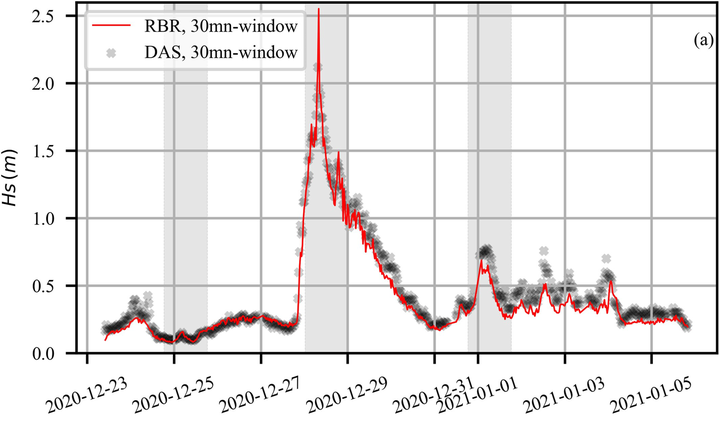Reconstruction of Nearshore Surface Gravity Wave Heights From Distributed Acoustic Sensing Data
 Reconstruction of wave heights from DAS data (black) compared to the reference of a colocated pressure sensor (red).
Reconstruction of wave heights from DAS data (black) compared to the reference of a colocated pressure sensor (red).
Abstract
Distributed Acoustic Sensing (DAS) is a photonics technology converting seafloor telecommunications and optical fiber cables into dense arrays of strain sensors, allowing to monitor various oceanic physical processes. Yet, several applications are hindered by the limited knowledge of the transfer function between geophysical variables and DAS measurements. This study investigates the quantitative relationship between surface gravity DAS-recorded wave-generated strain signals along the seafloor and the pressure at a colocated sensor. A remarkable linear correlation is found over various sea conditions allowing us to reliably determine significant wave heights from DAS data. Utilizing linear wave potential theory, we derive an analytical transfer function linking cable deformation and wave kinematic parameters. This transfer function provides a first quantification of the effects related to surface gravity waves and fiber responses. Our results validate DAS’s potential for real-time reconstruction of the surface gravity wave spectrum over extended coastal areas. It also enables the estimation of waves hydraulic parameters at depth without the need from offshore deployments.
This paper investigates the quantitative relationship between strain signals recorded by Distributed Acoustic Sensing (DAS) on seafloor cables and surface gravity waves. We establish a linear correlation that allows for the reliable determination of significant wave heights from DAS data across various sea conditions.
By deriving an analytical transfer function, we provide a first quantification of the effects linking cable deformation and wave kinematics. These results validate the potential of DAS for real-time, wide-area monitoring of the surface wave spectrum, which is crucial for coastal hazard assessment and oceanography.